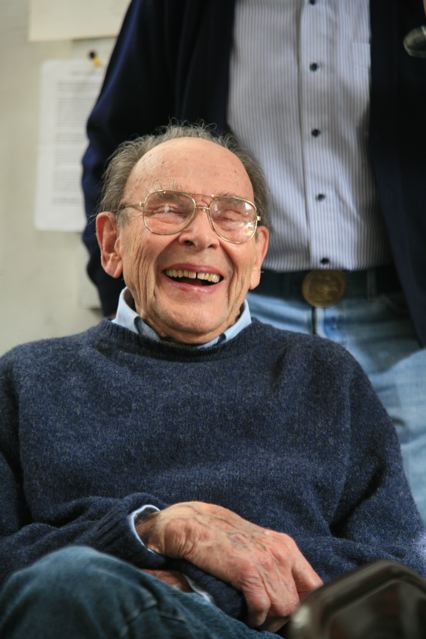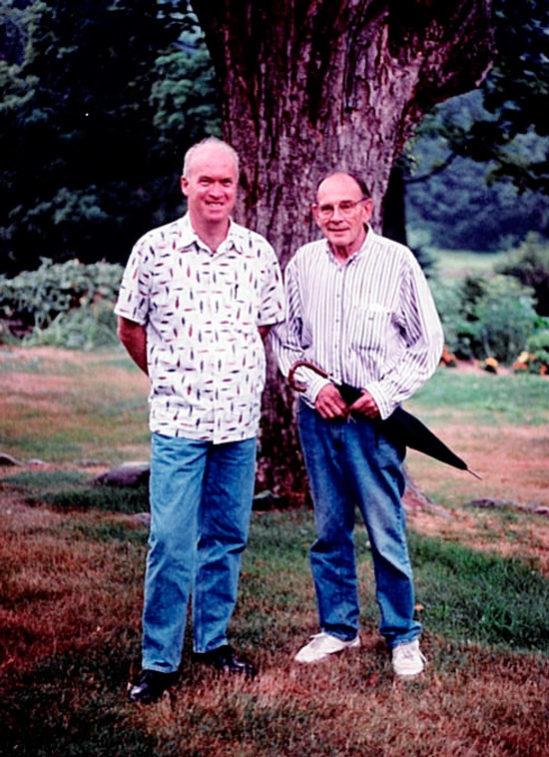The jazz inspiration of a New York painter
Charles Cajori, who died on December 1 at the age of 92, was one of the last of what constituted the second generation of Abstract Expressionist artists. Born in Palo Alto in 1921, grandson of the renowned Swiss mathematician Florian Cajori, Charles grew up on Philadelphia’s Main Line and studied at the Colorado Springs Art Center and Cleveland Art School before joining the Air Force in 1942. Four years later, he enrolled at Columbia on the GI Bill and soon realized that the post-WWII art world was becoming centered in Lower Manhattan.

Cajori became a denizen of the 10th Street art scene. He befriended Franz Kline and Willem DeKooning, hung out at the Cedar Tavern, and rented a $15 per month studio where he devoted himself to drawing and painting. In 1952, he was a co-founder with Lois Dodd and others of the Tanager Gallery, one of the first artist-run co-operatives in New York. A decade later, Cajori was among the charter members of the faculty of the New York Studio School where his colleagues included Philip Guston, Louis Finkelstein, and founder Mercedes Matter. He remained active as a teacher at the West 8th Street establishment until last year. He was also on the faculty at Queens College for many years beginning in 1965.
![Cajori Imagined Landscape II [1956]](https://digital.nepr.net/music/wp-content/uploads/sites/3/2014/03/Cajori-Imagined-Landscape-II-1956-e1493051806945.jpg)
I came to know Cajori through Jazz à la Mode, which he listened to and supported for 30 years from his home in Watertown, CT. Rummaging through some correspondence files last weekend, I found a letter addressed to the station on August 15, 1984, congratulating us on our new jazz format. It was signed “Barbara Grossman & Charles Cajori,” and its dateline may qualify it as the first piece of mail we received in support of Jazz à la Mode– the show had premiered nine days earlier. When I visited Cajori and Barbara for the first time a few years later, he was eager to show me the scores of cassette recordings he’d made of the program. A lively correspondent, Cajori’s letters invariably began with an update on players he’d just heard in the city; Barry Harris, Paul Motian, Joe Lovano, Tom Harrell, and Roy Hargrove were among his favorites, and the staff of the Village Vanguard knew him as a regular.

Like his friend and colleague Leland Bell, who made the painterly observation that saxophonist Lester Young’s style “respected a rhythm of angles,” seeing Lester with Count Basie in the late 30’s was a touchstone for Cajori. And just as the art world’s center shifted from Paris to New York in the late 40’s, the jazz scene was undergoing a change in locus from 52nd Street to Lower Manhattan at the same time. In New York terms, Harlem remained the music’s mythical home, but the creative currents were surging in Greenwich Village and Lower East Side venues like the Village Vanguard, Half Note, Village Gate, Slug’s, and the Five Spot. During its heyday in the late 50’s, the Five Spot was like a second home for Cajori, who could recall with vivid detail nights spent listening to Monk’s Quartet with John Coltrane, Billie Holiday with Mal Waldron, Charles Mingus, Miles Davis, and Lennie Tristano over 37-cent beers. (The interview at bottom with Cajori and sculptor Tom Doyle underscores the purchasing power of pennies a half century ago.) During Monk’s long residency at the Five Spot in 1957, a flyer for one of Cajori’s shows at the Tanager could be seen above the pianist’s chapeau-topped head.

Cajori’s work is in the permanent collections of the Metropolitan Museum of Art, the Hirshhorn Museum, and the Whitney. His painting, Epistrophy I, named for Monk and Kenny Clarke’s groundbreaking early ’40’s composition, is one of the showpieces at the Mattatuck Museum in Waterbury, CT. Cajori’s painting is analogous with Monk’s “Epistrophy.” For Cajori, the term refers to “the resolution of contrary movements in the formation of a crystal.” And while that wasn’t meant as a description of Monk’s music per se, I can hardly recall anything more concise and insightful, especially of “Epistrophy” itself. In general, the vertical sweep of many of Cajori’s paintings and drawings has parallels with Monk’s angularity, and he singled out the pianist’s use of space and silence as exemplary.
In a 2002 interview with art historian Jennifer Samet, Cajori discussed a block of black paint that he’d removed from his painting, “The Game,” because he saw it as an obstacle to the rhythm of the piece.
![The Game [1990-2000]](https://digital.nepr.net/music/wp-content/uploads/sites/3/2014/03/Cajori-The-Game-1990-2000.jpg)
“Everything is rhythm,” he said. “When I first became interested in art, about the same time, I became interested in jazz. I had been a drummer when I was in high school, and I always followed music and jazz. I feel a connection not only in the rhythm involved, which is continuous and non-climactic, but also the notion of improvisation. The rhythm is the control, I think. ”

Irving Sandler, in a 1961 review, said that Cajori was “trying to strike the perfect balance between freedom and discipline, ambiguous flux and calm, clear structure,” words that apply equally to jazz artists improvising on the structure, the space, so to speak, of composed works: popular songs, blues, and other established forms and norms. Ben LaRocca, writing in the Brooklyn Rail in 2005, said that Cajori’s painting, “exemplifies…the sense of individual struggle with history and lineage.” This grappling with influences was no less an issue for Cajori than it is for jazz musicians seeking to become innovators within their tradition. In terms of his art, Cajori’s Armstrong and Parker were Cezanne and DeKooning.

John Goodrich’s eulogy in artcritical began by noting that Cajori was not only an accomplished and acclaimed artist, “but extraordinarily generous and accessible as well.” To this I can only add, “Amen.” I’ll long cherish the memory of conversations with Cajori, and in particular his curiosity about what inspired my passion for jazz and interest in art. Cajori was a truly avuncular presence in my life, as he was for many others. As art and music are fields that many feel a calling toward early in life, both disciplines bring young people into the realm of the elders as teachers, mentors, and guiding lights. That’s a great responsibility for the masters, one requiring patience, openness, and trustworthiness. Cajori was well-suited to these imperatives.

A testimonial to this quality in Cajori came in the form of a letter that Bill Frisell addressed to him about a decade ago. The guitarist, who grew up in Denver, recalled an encounter with Cajori when he was in his early teens. Cajori’s father and Frisell’s father were colleagues at the Colorado Medical School. Bill remembered fondly the kindly attention that Cajori paid him on a visit to the Frisell home, and in particular that he’d brought along records by Monk, whom he was then unfamiliar with. As the years went on, Frisell often reflected on what a formative experience this was, and one day he used the internet to see if he could find a trace of Cajori. He found him, of course, and that occasioned the letter, which he hand-delivered to the Studio School. As it happened, Cajori had seen Frisell on a few occasions at the Vanguard with Lovano and Paul Motian, but he didn’t remember him as the kid he’d encouraged 40 years earlier. On Bill’s next trip to New York, they met for the first of what proved to be several get-togethers.

During one such meeting in Washington Square Park, Frisell was impressed with a statement Cajori made about his life’s work. “After all this time, the one thing I’m certain of is that drawing is a worthy endeavor.” Frisell borrowed the phrase for his composition, “A Worthy Endeavor (for Cajori).” He recorded it in 2010 for a release whose title, Beautiful Dreamers, named after the Stephen Foster parlor song, might also have been inspired by Cajori.Frisell quotes from it in his solo on “A Worthy Endeavor (for Cajori).” Frisell discussed his friendship with Cajori in an interview at the Walker Art Center in Seattle in 2010. It’s a sweet story told in halting terms beginning at 58:35 of this YouTube clip.
And here’s a delightful conversation between Cajori and the sculptor Tom Doyle in which they recall seeing Lady Day at the Five Spot; outsmarting the gas meter; the vicissitudes of making art; and DeKooning’s take on a Bowery bum’s adroit negotiation of space.
A memorial for Cajori is being held at the New York Studio School on Sunday, March 9, at 4 p.m. I’m honored to have been asked to be one of the speakers at the gathering celebrating the life and legacy of a man whom I was grateful to know as wise and principled, a wonderfully wry and humorous friend and mentor.
